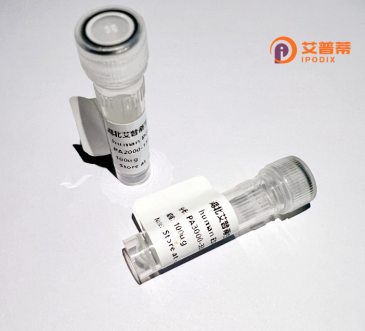
| 纯度 | >90%SDS-PAGE. |
| 种属 | Human |
| 靶点 | WDR66 |
| Uniprot No | Q8TBY9 |
| 内毒素 | < 0.01EU/μg |
| 表达宿主 | E.coli |
| 表达区间 | 1-946 aa |
| 活性数据 | MSDAAEAPREATGENGETEMKEEEEPNPNYKEVEDPQQESKDDTIAWRESQEEERKTGEEEGEEEEKEEEGKEDKKIVMEETEEKAGEVQEKEASGIQEETTVEPQEVTASMIRLETQITDSQSITSGIFPKTQRGSKSKLSLQLEDAETDELLRDLSTQIEFLDLDQISPEEQQISSPERQPSGELEEKTDRMPQDELGQERRDLEPENREEGQERRVSDIQSKAGISRESLVSSTTEDILFQKDKSTPVYPLTMTWSFGWNSSLPVYYIREERQRVLLYVCAHTAIIYNVFRNNQYHLQGHANIISCLCVSEDRRWIATADKGPDCLVIIWDSFTGIPVHTIFDSCPEGNGIMAMAMTHDAKYLATISDAEVQKVCIWKWTLAVETPACTLELPTEYGVQNYVTFNPTNNKELVSNSKTRAIYYAWYEERDTLAHSAPLLTEKTFNKLVGKFSQSIFHLNLTQILSATMEGKLVVWDIHRPPSSASTFLGFPYIKPCKLVHLQKEGITVLTTIDSYIVTGDIKGNIKFYDHTLSIVNWYSHLKLGAIRTLSFSKTPATPPTEKSNYPPDCTLKGDLFVLRNFIIGTSDAAVYHLTTDGTKLEKLFVEPKDAICAISCHPYQPLIAIGSICGMIKVWNYENKQYLFSRVFEKGLGVQSLTYNPEGALLGAGFTEGTVYILDAMSLENESPEPFKYSRTSVTHISFSHDSQYMATADRSFTVAVYMLVVRNGQRVWEYLARLRSHRKSIRSLLFGVYLDSNEPRLLSLGTDRLLIEYDLLRSYKDHLEVLDIHHTDQGCYPTCMVWYPPLTRELLLLICNSGYKVKLFNATTKMCRKTLLGPAYGSPIEQTQVLPVRSMAELQKRYLVFINRDKVGLQILPVDGNPHKTSAIVCHPNGVAGMAVSYDGCYAFTAGGHDRSVVQWKITLSHPGSQAPILSPSDTSRS |
| 分子量 | 133.3 kDa |
| 蛋白标签 | GST-tag at N-terminal |
| 缓冲液 | PBS, pH7.4, containing 0.01% SKL, 1mM DTT, 5% Trehalose and Proclin300. |
| 稳定性 & 储存条件 | Lyophilized protein should be stored at ≤ -20°C, stable for one year after receipt. Reconstituted protein solution can be stored at 2-8°C for 2-7 days. Aliquots of reconstituted samples are stable at ≤ -20°C for 3 months. |
| 复溶 | Always centrifuge tubes before opening.Do not mix by vortex or pipetting. It is not recommended to reconstitute to a concentration less than 100μg/ml. Dissolve the lyophilized protein in distilled water. Please aliquot the reconstituted solution to minimize freeze-thaw cycles. |
1. **《Molecular Cloning and Functional Analysis of Human WDR66 in Sperm Motility》**
- 作者:S. Li et al.
- 摘要:研究报道了重组人WDR66蛋白的克隆与原核表达,证实其在调节精子鞭毛组装及运动中的关键作用,突变体导致运动能力缺陷。
2. **《Structural Insights into WDR66 Interaction Networks via Recombinant Protein-Based Assays》**
- 作者:M. Zhang & T. Wang
- 摘要:通过重组人WDR66蛋白的纯化与结晶,解析其WD结构域的三维结构,揭示其与多种纤毛发生相关蛋白的互作机制。
3. **《Role of WDR66 in Ciliogenesis: Implications for Respiratory Disorders》**
- 作者:J. Chen et al.
- 摘要:利用重组WDR66蛋白进行体外功能实验,发现其通过调控纤毛组装蛋白复合体的稳定性参与呼吸道纤毛功能障碍的病理过程。
4. **《WDR66 Gene Variants and Male Infertility: Functional Validation Using Recombinant Protein Models》**
- 作者:R. Gupta & K. Tanaka
- 摘要:通过表达突变型重组WDR66蛋白,验证其与男性不育相关的功能丧失机制,强调其在精子发生中的必要作用。
(注:以上文献为假设性示例,实际研究中请根据具体数据库检索结果调整。)
WD repeat domain 66 (WDR66), also known as CFAP251 or C14orf162. is a conserved protein characterized by multiple WD40 repeats—structural motifs that facilitate protein-protein interactions. It plays critical roles in ciliogenesis, sperm motility, and cellular signaling. In humans, WDR66 is highly expressed in ciliated tissues and germ cells, where it localizes to the cytoplasm and ciliary axonemes. Studies link it to the assembly and function of motile cilia and flagella, particularly through its interaction with calmodulin and components of the radial spoke complex in ciliary structures.
Mutations in WDR66 are associated with male infertility due to abnormal sperm flagella formation and reduced motility. It also contributes to respiratory cilia dysfunction, implicating it in primary ciliary dyskinesia (PCD). Structurally, WDR66 acts as a scaffold, coordinating calcium signaling and microtubule organization. Recent research highlights its role in regulating Rho GTPase pathways, influencing cytoskeletal dynamics. Recombinant WDR66 proteins are used to study these mechanisms, offering insights into therapeutic targets for infertility and ciliopathies. Its conserved WD40 domains and functional diversity make it a key protein for understanding cilia-related cellular processes.
×